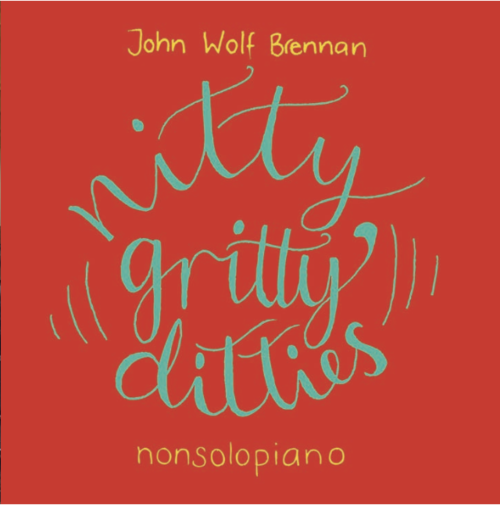John Wolf Brennan – Nitty Gritty Ditties

J
Leo Records
Read English translation by John Wolf Brennan below please...
Es gibt Alben mit nichtssagenden Covers; es gibt solche, bei denen das Booklet lediglich eine Fotostrecke präsentiert. Es gibt schließlich welche, die nicht einmal die Lyrik abdrucken, obgleich das Album aus Gesangsstücken besteht. Und zuletzt gibt es solche, die einen hohen intellektuellen Anspruch beinhalten, doch diesem nicht genügen. Nun gut, damit muss man leben. Zum Glück gibt es aber auch Musiker, die nicht der Auffassung sind, ihre Musik sei selbst erklärend oder die musikalische Inszenierung erschließe sich auf den ersten oder zweiten Blick. Zu jenen, die das nicht unterstellen und die das Wort ebenso wesentlich finden wie die Musik, gehört der Pianist John Wolf Brennan. Sein Booklet zum aktuellen Album ist erstklassig. Er lässt den Hörer nicht mit dem Albumtitel allein und „seziert“ auch im Detail den musikalischen Aufbau des Albums, das insgesamt 33 Stücke präsentiert, einschließlich eines Schnelldurchlaufs durch alle gespielten Stücke am Ende des Albums. In der Unterzeile zum Album ist von „nonsolopiano“ die Rede. Das ist zum einen zutreffend, weil auch die Vokalistin Anna Murphy bei drei Stücken mitwirkt, zum anderen weil Brennan auch Hammond B3, Wurlitzer Piano, Toy Piano, Rhodes und Melodica spielt, mal abgesehen von Arco- oder Sordinopiano.
Nun gut, Kenntnisse in Englisch muss man besitzen, will man Brennans Erläuterungen verstehen, angefangen von der Frage nach dem Albumtitel über die nach der Rolle des Basses oder von Polystilistik. Auf alle Fälle geht Brennan den aufgeworfenen Fragen und Teilaspekten seines Albums auf den Grund. „Nitty Gritty“ ist genau der richtige Begriff dafür, übersetzt mit „einer Sache auf den Grund gehen“, „in das Zentrum des Problems vordringen“, „das Essentielle herausschälen“. Und „Ditties“ sind schlicht kurze Lieder, die eine Mutter ihrem Kind vorsingt, ob das nun stets Schlaflieder sind, ist eine ganz andere Frage. „Bit for Bit“ und „Bytes for Bytes“ stellt der Pianist auch die einzelnen Stücke vor, beginnend bei dem Stones-Song „We love you, Eskimo“ über „Tell Her You Saw Me“ (Pat Metheney), „Funky Two Five“ (Tim Richards), „Equus“ (Aram Khachaturian), „Blue in Green“ (Bill Evans) und „Silence“ (Charlie Haden) bis hin zu „She Could Be Mine“ (Don Grusin) und „No Walk Today“ (Aram Khachaturian).
Klassik, Rock, Folk und Jazz – das ist die Melange, die uns der Pianist auf dem aktuellen Album präsentiert. Es sind kurze Stücke, für Jazz mit seinen charakteristischen Improvisationen eher untypisch und eher aus der Popmusik bekannt. Vielleicht könnte man auch von musikalischen Schnipseln reden, ganz im Sinne von Kurt Tucholskys „Schnipseln“, ernste und heitere Spruchweisheiten. Obendrein kann man Brennans musikalisches Konvolut aber auch als eine Sammlung von Mosaiksteinchen ansehen, die zusammengesetzt, die verschiedenen Facetten der Musikgeschichte reflektieren, jenseits aller Genregrenzen. Zugleich ist es Brennan gelungen, zum Beispiel Rocksongs völlig aus dem gängigen Kleid der Instrumentierung herauszuschälen und so einen ganz anderen Zugang dazu möglich zu machen.
Doch nun zu den „Hörproben“: „We Love you, Eskimo“ ist ein gutes Beispiel für einen Rocksong, den Brennan adaptiert und als Mutante erscheinen lässt, dabei klassische Momente einfangend, aber auch Folkloristisches. Kristalline Strukturen werden vor dem Hörer ebenso ausgebreitet wie energiegeladene Tastensetzungen, die anmuten, als würde ein Hindernisrennen musikalisch eingefangen. „Tell Her You Saw Me“ lebt ja im Original von Metheneys Saitenspiel. Brennan jedoch konzentriert sich auf den Klangfluss. Dabei scheint er kammermusikalisch unterwegs zu sein, oder? Wollte man ein Bild bemühen, so hat man Regentropfen vor Augen, die nach einem Starkregen, nach und nach vom Blattwerk der Bäume perlen und auf dem Gehweg zerplatzend aufschlagen.
„Childrens Song No. 3“ lebt durch die Klangverknüpfung von Melodica und Klavier. Dabei haucht die Melodica der Präsentation ein wenig Fusion ein. Sie ist die tragende Melodiestimme über den redundanten Passagen des Klaviers. Aus dem Off vernehmen wir den „schrillen Klang“ der Melodica, wenn wir „Microcosm No. 69“ hören. Béla Bartók ist dieses Stück geschuldet, doch bei der Brennanschen Interpretation kommt dem einen oder anderen wohl auch die Filmmusik von Enrico Morricone in den Sinn, der nicht nur die Musik für „Spiel mir das Lied vom Tod“ komponierte. Elektronische Musik oder Sphärenklang – das ist zu Beginn die Frage bei „Song for Everyone“. Im weiteren Verlauf entwickelt sich das Stück, geprägt durch Brennans Spiel, zu einem eingängigen Popsong aus den späten 60er und frühen 70er Jahren, so könnte man meinen. Auch an die diversen Versuche der Popularisierung der Klassik wird man beim Hören erinnert.
Bei „For No One“ ist Anna Murphy als Sängerin zu hören, im Duett mit John Wolf Brennan. Dabei schien im Ohr des Rezensenten auch Mary Hopkins „Those were the days“ mitzuschwingen. Fehlgeleiteter Höreindruck? Steve Swallow wird auf dem Album mit „Sweeping Up“ lebendig, ebenso wie nachfolgend in „Utviklingssang“ auch Carla Bley, die beide immer noch auf den Jazzbühnen zu hören sind, trotz ihres hohen Alters.
Mit fließender „Baritonstimme“ vernehmen wir das Wurlitzer-Piano in „You Know You Know“, dabei von den scharfen Tastensetzungen des Pianos im Fortgang unterbrochen. Und auch eine teils exaltiert erscheinende Melodica mischt sich in den Melodiefluss der Komposition von John McLaughlin ein. Dabei erscheint dann das Stück als eine Zusammensetzung von Fragmenten, von bunten Glasscherben, die darauf warten, an den richtigen Platz gesetzt zu werden. Wüsste man es nicht besser, so würde man meinen, Brennan würde mit Toots Tielemans in „Funky Two Five“ zu hören sein. Die Melodica klingt sehr ausgeprägt nach der Mundharmonika, wie sie der Doyen aus der Brüsseler Hoogstraat, TootsTielemans, gespielt hat. Referenz an seine irischen Wurzeln ist wohl „Too-Ra-Loo-Ra-Loo-Ral“, eine irische Volksweise, die Brennan auch in das aktuelle Album integriert hat und die so gar nichts von The Dubliners und anderen Folkmusikern aus Irland hat, die einst regelmäßig die Hallen in Deutschland füllten. Und auch „The Lord of the Dance“ ist nicht gegenwärtig. Stattdessen könnte man beim Hören an eine Etüde für Klavier denken. Das Traben und Galoppieren eines Pferdes wird in Khachaturians „Equus“ eingefangen. Dabei hört man Brennan auch am Rhodes.
Mit „Blue in Green“ von Bill Evans ist ein ikonisches Werk Teil der Albumpräsentation. Das Stück ist auch auf dem legendären Album „Kind of Blue“ von und mit Miles Davis zu hören. Dabei vermengen sich bei Brennan Rhodes und Piano, beide im Klang weit entfernt von der leicht gedämpften Trompete eines Miles. Und doch fängt Brennan den Charakter des Stücks ein, das auch eine gewisse Schwermut auszustrahlen scheint. Bei „Boeves Psalm“ kann man die Vorstellung gewinnen, Brennan würde eine große niederländische Drehorgel bedienen, die suggeriert, ein komplettes Orchester sei engagiert worden. Doch lediglich Piano und Toy Piano sind bei Brennan mit im Spiel. Im Übrigen erinnert die Melodie stark an einen Gassenhauer aus den 1920er Jahren oder an Kirmesmusik, oder? Eigentlich hatte der aus Uppsala stammende Lars Hollmer das Stück wohl für Akkordeon konzipiert. Doch Brennan verzichtet in seiner Interpretation auf ein Zuginstrument. Und das tut dem Stück keinen Abbruch.
Mit einem „Tango“ von Tom Waits setzt Brennan seine musikalische Reise jenseits aller Grenzziehungen fort. Sie beinhaltet außerdem „Mannenberg“ (Abdullah Ibrahim), „Gentle Piece“ (Kenny Wheeler) und auch einen Kanon für neun Stimmen namens „Hey Ho What Shall I Say“. Fazit: Brennan präsentiert Musik als mondiale Sprache, schert sich nicht um Genres und Subgenres und bietet dem Hörer ein farbenprächtiges Klangbouquet für mehr als eine Stunde.
© ferdinand dupuis-panther
Infos
http://www.leorecords.com
https://www.brennan.ch
ENGLISH TRANSLATION BY JOHN WOLF BRENNAN:
There are albums with meaningless covers; there are those in which the booklet only presents a series of photos. After all, there are those who do not even print the lyrics, although the album consists of vocal pieces. And finally, there are those who have high intellectual standards, but do not meet them. Well, you have to live with that. Fortunately, there are also musicians who do not believe that their music is self-explanatory or that the musical staging is obvious at first or second glance. Pianist John Wolf Brennan is one of those who do not assume this and who find the word as essential as the music. His booklet for the current album is first class. He does not leave the listener alone with the album title and "dissects" the musical structure of the album in detail, which presents a total of 33 pieces, including a quick run through all the pieces played at the end of the album. In the subline of the album there is talk of “nonsolopiano”. This is true on the one hand because vocalist Anna Murphy is also involved in three pieces, on the other hand because Brennan also plays Hammond B3, Wurlitzer piano, toy piano, Rhodes and melodica, apart from arco or sordinopiano.
Well, you need some knowledge of English if you want to understand Brennan's explanations, starting with the question about the album title to the role of the bass or about polystyle. In any case, Brennan gets to the bottom of the questions raised and partial aspects of his album. "Nitty Gritty" is exactly the right term for it, translated as "getting to the bottom of a thing", "getting into the center of the problem", "peeling out the essentials". And "ditties" are simply short songs that a mother sings to her child, whether these are always lullabies is a completely different question. The pianist also introduces the individual pieces “Bit for Bit” and “Bytes for Bytes”, starting with the Stones song “We love you, Eskimo” through “Tell Her You Saw Me” (Pat Metheney), “Funky Two Five” "(Tim Richards)," Equus "(Aram Khachaturian)," Blue in Green "(Bill Evans) and" Silence "(Charlie Haden) to" She Could Be Mine "(Don Grusin) and" No Walk Today " (Aram Khachaturian).
Classical, rock, folk and jazz - that is the mix that the pianist presents to us on the current album. They are short pieces, rather untypical of jazz with its characteristic improvisations and more familiar from pop music. Perhaps one could also speak of musical snippets, in the spirit of Kurt Tucholsky's “snippets”, serious and cheerful sayings. On top of that, Brennan's musical collection can also be seen as a collection of mosaic stones that, put together, reflect the various facets of music history, beyond all genre boundaries. At the same time, Brennan succeeded, for example, in peeling rock songs completely out of the usual instrumentation and thus making a completely different approach to them possible.
But now to the “audio samples”: “We Love you, Eskimo” is a good example of a rock song that Brennan adapts and lets appear as a mutant, capturing classic moments, but also folklore. Crystalline structures are spread out in front of the listener as well as energetic keystrokes that seem as if an obstacle race was captured musically. “Tell Her You Saw Me” lives in the original from Metheney's string playing. Brennan, however, focuses on the flow of sound. He seems to be playing chamber music, right? If you wanted to try a picture, you have raindrops in front of your eyes, which after heavy rain, gradually pearl off the foliage of the trees and burst on the sidewalk.
"Childrens Song No. 3 “lives through the sound combination of melodica and piano. The melodica breathes a little fusion into the presentation. She is the supporting melody voice over the redundant passages of the piano. From the off we hear the “shrill sound” of the melodica when we say “Microcosm No. 69 “hear. This piece is owed to Béla Bartók, but with Brennan's interpretation, the film music by Enrico Morricone, who not only composed the music for "Play me the song of death", comes to mind. Electronic music or spherical sound - that is the question at the beginning with "Song for Everyone". In the further course the piece, shaped by Brennan's playing, develops into a catchy pop song from the late 60s and early 70s, one might think. One is reminded of the various attempts to popularize the classical music while listening.
In “For No One” Anna Murphy can be heard as the singer, in a duet with John Wolf Brennan. Mary Hopkins “Those were the days” also seemed to resonate in the ear of the reviewer. Misguided auditory impression? Steve Swallow comes alive on the album with “Sweeping Up”, as does Carla Bley in “Utviklingssang”, both of whom can still be heard on the jazz stages despite their old age.
With a flowing “baritone voice” we hear the Wurlitzer piano in “You Know You Know”, interrupted by the sharp keystrokes of the piano in the process. And a melodica that sometimes appears exalted interferes with the melodic flow of John McLaughlin's composition. The piece then appears as a composition of fragments, of colorful shards of glass that are waiting to be put in the right place. If you didn't know better, you would think Brennan could be heard with Toots Tielemans in “Funky Two Five”. The melodica sounds very pronounced like the harmonica played by the doyen from the Hoogstraat in Brussels, Toots Tielemans. Reference to his Irish roots is probably "Too-Ra-Loo-Ra-Loo-Ral", an Irish folk tune that Brennan has also integrated into the current album and that has nothing at all from The Dubliners and other folk musicians from Ireland once regularly filled the halls in Germany. And “The Lord of the Dance” is not present either. Instead, while listening, one might think of an étude for piano. The trotting and galloping of a horse is captured in Khachaturian's "Equus". You can also hear Brennan on the Rhodes.
With “Blue in Green” by Bill Evans, an iconic work is part of the album presentation. The piece can also be heard on the legendary album "Kind of Blue" by and with Miles Davis. With Brennan Rhodes and piano merge, both in sound far removed from the slightly muffled trumpet of a Miles. And yet Brennan captures the character of the piece, which also seems to exude a certain melancholy. With “Boeves Psalm” one can get the idea that Brennan would operate a large Dutch barrel organ, which suggests that a complete orchestra has been hired. But only piano and toy piano are involved with Brennan. Incidentally, the melody is very reminiscent of a hit song from the 1920s or of fair music, right? Lars Hollmer from Uppsala actually designed the piece for the accordion. But Brennan dispenses with a pulling instrument in his interpretation. And that doesn't detract from the piece.
With a “Tango” by Tom Waits, Brennan continues his musical journey beyond all boundaries. It also includes "Mannenberg" (Abdullah Ibrahim), "Gentle Piece" (Kenny Wheeler) and also a canon for nine voices called "Hey Ho What Shall I Say". Conclusion: Brennan presents music as a mondial language, does not care about genres and subgenres and offers the listener a colourful bouquet of sounds for more than an hour.
© ferdinand dupuis-panther (Translation: John Wolf Brennan)













